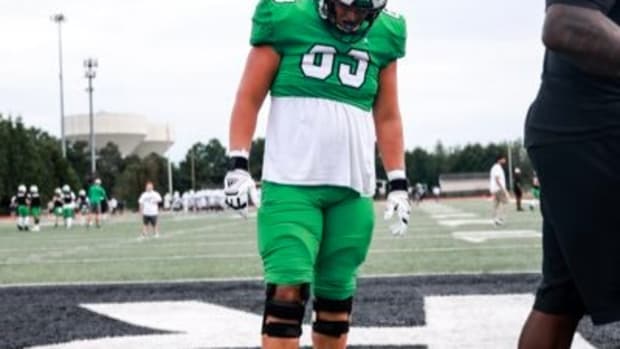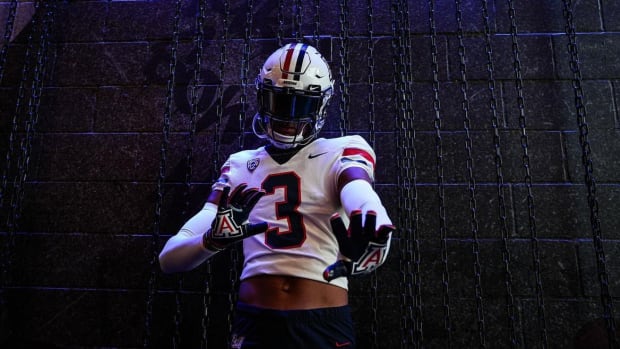39 Days Until Kansas Football: TV Numbers and Realignment
Before we get started, I've decided that I'm getting tired of constantly talking about conference realignment. While the rest of the college football world seems intent on telling everyone else what SHOULD happen with the national landscape (whether their school is involved or not), there are plenty of other topics to explore and discuss as we get geared up for the season.
So that means that for the purposes of my own sanity, I only plan to write about conference realignment at most once each week, unless some true insanity shocks the world. With that said, here is your dose of realignment news for the week.
As is usually the case on Twitter, a vicious debate started raging today, and it has wholly consumed the college football world. The culprit? An article by Stewart Mandell of The Athletic that "proves" that the Pac-12 is in a pretty good spot relative to the Big 12.
While I had some worries about reading too far into TV numbers as the final word on realignment, it's hard to deny their importance, so I clicked through and read the article in its entirety. I couldn't have been more disappointed.
Normally I'm not one to bring things from behind a paywall to a free site, as I know how much work goes into putting together a well researched article. And I agree that this article used a lot of research and raised some important points worth discussing, so go give it a read if you have a subscription.
That being said, there are several points that Mandel points to in his article that are just plain wrong or taken so far out of context to make his point that they actually work against him.
Identifying Important Factors
In analyzing a set of data, the things that you ignore as possible explanations for the patterns you are seeing are just as important as the things that are proposed as explanations. In fact, if you want to make a comparison about the relative value of school brands (as measured by tv viewership numbers), it is essential to identify which differences between schools are features, and which are circumstances that could potentially change.
You can think of features like a baseline level of ability for an athlete and the circumstances as akin to the coaching and training that a player receives. If two players are performing at different levels, that performance is governed by both their baseline ability and the coaching that they have received. You can change the circumstances by adjusting the level of coaching or training, but it's very difficult to adjust that base talent.
And here is where the analysis in the article fails the most, by being inconsistent about whether certain things are features of the schools or just a circumstance that they are benefiting from.
Channel Placement
Let's start with the big issue, not controlling for channel placement. Mandel's article talk about the network deals and how the biggest games are being put on mainline ABC and FOX channels. That point is absolutely true, as Oklahoma and Texas are guaranteed to be on one of those channels if their game is even mildly worth watching with other good teams in their conference. So his analysis removes any game that included Oklahoma and Texas.
But if you acknowledge that channel placement makes a difference (and thus makes the loss of Texas and Oklahoma a bigger deal than the loss of UCLA and USC), then you have to also acknowledge how the placement of those games affect the TV numbers. After all, it's impossible to deny that an Iowa State-Oklahoma State game on FOX is going to draw more viewers than the exact same game on FS1.
But there is no accounting for this in the numbers. The remaining 8 members of the Big 12 has a much higher percentage of their games on FS1 and ESPNU than the PAC 12, which obviously is an advantage.
So when Oklahoma and Texas leave, it's fair to assume that at least some portion of those favorable channel slots will go to the remaining Big 12 schools, negating some of this difference.
Time Slots
One of the big assertions of the article is that the PAC 12 benefits from being the only game in town for the late night slots on Saturdays. And that is definitely true. It likely provides a huge amount of value.
But guess what was ignored? The fact that FOX and ABC absolutely LOVE to put Big 12 teams on their channels in the 11am timeslot, a spot that is not feasible for west coast teams. And as we saw above, those slots average a lot more viewers. It's perfectly reasonable to assume that a majority of these spots vacated by Oklahoma and Texas would go to the other Big 12 teams, thereby increasing their average viewership.
To put it simply, there are more viewers to be had during the day, even if those viewers have to be split between multiple games.
To make his point about the late night spot, he talks about how an Arizona State-Oregon State outdrew the viewership of a Texas-West Virginia game on the same day. But that ignores the fact that the Pac 12 game drew right 500k fewer viewers than the median for that time slot based on channel, while the Big 12 game drew 300k more than the median, despite competing with other huge matchups. Simply put, channel matters, even more than timeslot.
Exclusivity
The crux of Mandel's article is that Pac 12 is in a good enough position when drawing viewers that they should be able to compete in TV money. And the implication is that by potentially moving from the Pac 12 to the Big 12, they are forfeiting the ability to play in the late time slots and losing value by moving to worse channels.
But this ignores the fact that the Pac 12 is the only conference that plays in that timeslot because they are the only conference that have teams on the west coast. But if Arizona moves to the Big 12, they don't magically change timezones. The Wildcats can still play home games in that late window, and a theoretical move would include other western schools that would give the Big 12 the inventory it needs to scoop up that time slot.
Plus, it's no longer going to be an exclusive timeslot for one conference. USC and UCLA can play Big Ten games in that spot. BYU can play Big 12 games in that spot. Soon the conference may have to compete for eyeballs, which means they might have to start splitting those late night viewers.
To wrap this up, I don't think there is enough information out there right now to definitively compare the prospects of the Pac 12 to other conferences. Ultimately, the lack of competition for the conference media rights may be more important in driving the price than the ability to offer games in specific timeslots.
But one thing is clear: the data used to try to pump up the Pac 12 this year is just as flawed as the data that was used last year to try and kill the Big 12.
Join the discussion! Come talk about this or any of our articles on the Blue Wing Rising Discord Server.
Follow Blue Wings Rising on Twitter.
Listen to the official podcast of Blue Wings Rising: The Rock Chalk Podcast.




